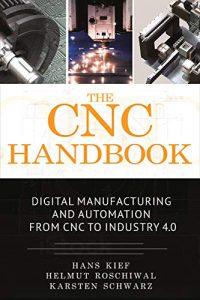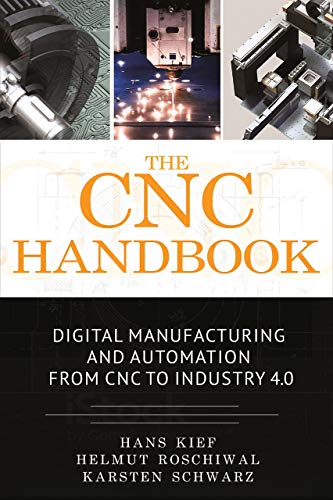The CNC Handbook Digital Manufacturing and Automation from CNC to Industry 4 0 First Edition by Hans Bernhard Kief, Helmut A. Roschiwal, Karsten Schwarz 9780831194987 0831194987
$50.00 Original price was: $50.00.$25.00Current price is: $25.00.
The CNC Handbook Digital Manufacturing and Automation from CNC to Industry 4 0 First Edition Kief – Ebook Instant Download/Delivery ISBN(s): 9780831194987, 0831194987

Product details:
- ISBN 10:0831194987
- ISBN 13:9780831194987
- Author: Hans Bernhard Kief, Helmut A. Roschiwal, Karsten Schwarz
The CNC Handbook
Digital Manufacturing and Automation from CNC to Industry 4.0
Table contents:
Part 1 Introduction to CNC Technology
1 Historical Development of Numerical Control Production
Germany after World War II
Rebuilding the German Machine Tool Industry
Machine Tool Industry in Eastern Germany
Worldwide Changes
Advancement of the German Machine Tool Industry
The Japanese Influence
The Crisis in Germany
Causes and Effects
Flexible Manufacturing Systems
World Economic Crisis of 2009
Situation and Outlook
Conclusion
2 Milestones in the Development of Numerical Control
3 What Is NC and CNC?
The Path to NC
Hardware
Software
Control Methods
NC Axes
Programmable Logic Controllers
Interface Section
Computers and NC
NC Programs
Programming
Data Input
Operation
Summary
Important Points to Remember
Part 2 Functions of CNC Machine Tools
4 Positional Data Input
Introduction
Axis Designations
Closed-Loop Position Control
Position Measurement
Simple Diagnosis of Measurement Devices
Compensations
Important Points to Remember
5 Switching Functions
Explanations
Tool Change
Tool Changing at Milling Machines and Machining Centers
Tool Changing on the Lathe
Tool Location Coding
Workpiece Change
Spindle Speed Change
Feed Rate
Summary
Important Points to Remember
6 Operating Functions of Numerical Control Systems
Definition
Basic Functions of CNC
Special Functions of CNC Systems
Dynamic Collision Monitoring
Integrated Safety Concepts for CNC Machines
Condition Monitoring and Machine Data Collection
Displays in CNC Systems
Touch Operation of the CNC System
Open Controls
Price Consideration
Advantages of Newest CNC Developments
Summary
Important Points to Remember
7 Programmable-Logic Controllers (PLCs)
Definition
Origins of PLC
Structure and Functions of PLCs
Data Buses and Field Buses
Advantages of PLCs
PLC Programming and Documentation
Program
Program Memory
PLCs, CNC Systems, and PCs in Integrated Operation
Selection Criteria for PLCs
Summary
Comparison Tables CNC/PLC
Important Points to Remember
8 Effects of CNC on Machine Components
Machine Configuration
Machine Frames
Guides
Machine Enclosures
Coolant Supply
Chip Removal
Summary
Important Points to Remember
Part 3 Electrical Drives of CNC Machine Tools
9 Drive Control for CNC Machine Tools
Definition
Mechanical Axis
Analog Control
Analog versus Digital Position Control
Digital Intelligent Drive Technology
Controller Types and Controlling Behavior
Loop Gain and Kv Factor
Precontrol
Frequency Converter
Summary
Important Points to Remember
10 Feed Drives for CNC Machine Tools
Requirements for Feed Drives
Types of Feed Drives
Types of Linear Motors
Advantages/Disadvantages of Linear Drives
Connection of the Drives to the CNC System
Encoder
Summary
Important Points to Remember
11 Main Spindle Drives
Requirements for Main Spindle Drives
Types of Main Spindle Drives
Designs of Main Spindle Drives
Types of Three-Phase Synchronous Motors
Advantages and Disadvantages of Three-Phase Synchronous Motors
Important Points to Remember
12 Dimensioning of Drives for Machine Tools
Procedure
Example
Dimensioning of Main Spindle Drives
Example
Summary
Important Points to Remember
13 Mechanical Layout of the Main Spindle Based on the Process Parameters
Motor Selection
Bearings
Lubrication
Machining Processes
Requirements for the Main Spindle in Terms of Industry 4.0
Important Points to Remember
Part 4 Kinds of CNC Machines
14 CNC Machine Tools
Machining Centers, Milling Machines
Lathes
Grinding Machines
Gear-Cutting Machines
Drilling Machines
Sawing Machines
Laser Machining Systems
Punching and Nibbling Machines
Tube-Bending Machines
Electrical-Discharge Machines
Wire EDM
Electron-Beam Machines
Water-Jet Cutting Machines
Multitasking Machines
Measuring and Testing
Summary
Important Points to Remember
15 Additive Manufacturing Processes
Introduction
Definition
Process Chain
Classification of Additive Manufacturing Processes
Introduction to the Principal Layer Manufacturing Processes
Advantages of Additive Manufacturing
Summary
Important Points to Remember
16 Flexible Manufacturing Systems
Definition
Flexible Manufacturing Cells.
Flexible Manufacturing Systems
Technical Characteristics of FMSs
Application Criteria for FMSs
Manufacturing Principles
Machine Selection and Layout
Workpiece Transport Systems
CNC Systems Suitable for Flexible Manufacturing
Host Computers in FMSs
Economic Advantages of FMSs
Problems and Risks in the Design of FMSs
Flexibility and Complexity.
Simulation of FMSs
Production Planning Systems
Summary
Important Points to Remember
17 Industrial Robots and Handling
Introduction
What Is an Industrial Robot?.
Structure of Industrial Robots
Mechanical Elements/Kinematics
Gripper or Effector
CNC Systems
Safe Robot Technology
Programming
Sensors
Application Examples for Industrial Robots
CNC-Robot Machining and Machine Tool Automation
Robot with CNC Requirements
Application Criteria for Industrial Robots
Summary and Outlook
Important Points to Remember
18 Energy-Efficient, Cost-Effective Fabrication
Introduction
What Is Energy Efficiency?
Work Floor
Machinery
Special Case: Machining Centers
Energy-Efficient NC Programs
Options of the Machine Manufacturer
Options for the User
Reactive Power Compensation
What Is Reactive Power?
Summary
Outlook
Important Points to Remember
Part 5 Tools in CNC Production
19 Tool Construction
Introduction
Requirements
Outline of Tools
Machine-Based Tool Holders
Modular Tool Systems
Adjustable Tools
Thread Milling
Custom Tools
Tool Selection
Important Points to Remember
20 Tool Management.
Motives for Introduction
Evaluation of a Tool Management System.
Assessment of Solutions.
Introduction of a Tool Management System
Outline
Integration
Tool Identification
Retrieving Tools
Tool Classification
Tool Components
Complete Tools
Tool Lists
Operations
Tool Presetting
Tool Logistics
Electronic Tool Identification
Summary
Important Points to Remember
21 Machine-Integrated Workpiece Measurements and Process Control
Introduction
Starting Points for Process Control
Areas of Application of Workpiece and Tool Measuring Systems
Workpiece Measurement Systems for Machine Tools
Important Points to Remember
22 Machine-Integrated Workpiece Measurements in Series Production
Introduction
Bore-Measuring Heads for Shortest Measuring Times in Bore Production.
Roughness-Measuring Devices for the Automated Surface Test
Digilog Probe for Digital and Analog Data Acquisition
Highest Productivity with Simultaneous Measurement
Summary
Important Points to Remember
23 Laser-Based Tool Monitoring
Introduction
Tool Breakage Monitoring
Single-Cutting-Edge Control
Measurement of HSC Tools
Combined Laser Measurement Systems
Summary
Important Points to Remember
Part 6 NC Program and Programming
24 The CNC Program
Definitions
Structure of the NC Program.
Program Structure, Syntax, and Semantics
Miscellaneous (M) Functions
Positioning Data
Preparatory (G) Functions
Machining Cycles
Zero Points and Reference Points
Transformations
Tool Corrections
DXF Converter
High-Level Language Programming
Summary
Important Points to Remember
25 Programming CNC Machines.
Definition of NC Programming
Programming Methods
CAM-Based CNC Machining Strategies
User-Friendly Graphics
CNC Identical Programming Systems
Selection of the Appropriate Programming System
Summary
Important Points to Remember
26 NC Programming Systems
Introduction
Changing Machining Processes
Area of Application Sets the Priorities
Input Data from Different Sources
Scope of a Modern Computer-Aided Programming (CAP) System
High-Level Data Models
CAM-Oriented Geometry Manipulation
High-Performance Machining Strategies Are Paramount
Adaptive Processing
3D Models Offer More
3D Interfaces
Innovation with Feature Technology
Automation of NC Programming
Tools
Clamping Planning and Definition of the Sequence
The Importance of Simulation
Postprocessor
Generated Data and Interfaces with the Machine Tools
Summary
Important Points to Remember
27 Manufacturing Simulations
Introduction
Qualitative Classification of Systems
Components of a Simulation Scenario
Procedure for NC Simulations
Integrated Simulation Systems
Fields of Application
Summary
Important Points to Remember
Part 7 From Company Information Systems to Industry 4.0
28 DNC: Direct Numerical Control or Distributed Numerical Control
Definition
Functions of DNC
Application Criteria for DNC Systems
Data Communication with CNC Systems
Methods for Requesting Programs
DNC Systems Currently Available
Network Technology for DNC Systems
Advantages of Using Networks
NC Program Management
Advantages of DNC Operation
Cost-Effectiveness of DNC
Current State and Trends
Summary
Important Points to Remember
29 LANs: Local-Area Networks
Introduction
Local-Area Networks (LANs)
What Is Information?
Characteristics and Features of LANs
Gateways and Bridges
Criteria for Selecting a Suitable LAN
Interfaces
Summary
Important Points to Remember
30 Digital Product Development and Manufacturing: From CAD and CAM to PLM
Introduction
Terminology and History
Digital Product Development
Digital Manufacturing
Summary
Important Points to Remember
31 Industry 4.0
Basics
Core Elements of Industry 4.0
Industry 4.0 in Production
MES as a Building Block of Industry 4.0
Challenges and Risks of Industry 4.0
32 Industry 4.0 in the Medium-Sized Company
Requirements for Industry 4.0
Benefits of Industry 4.0
Cyber-Physical Systems (CPSs), the Internet of the Things
Sixteen Case Studies about Industry 4.0
A Workday with Industry 4.0
People also search:
the cnc handbook digital manufacturing and automation
the cnc machine
cnc handbook
cnc machining handbook building programming and implementation
cnc handbook pdf
You may also like…
Engineering - Industrial Engineering & Materials Science
Engineering - Engineering - General & Miscellaneous
Business & Economics - E-Commerce
Engineering - Environmental
Sustainable Smart Manufacturing Processes in Industry 4 0 1st Edition Ramesh Kumar
Business & Economics - Industries
Engineering - Mechanical Engineering & Dynamics
Business & Economics - Logistics
Engineering - Industrial Engineering & Materials Science












